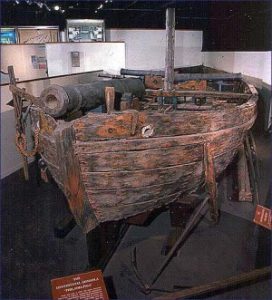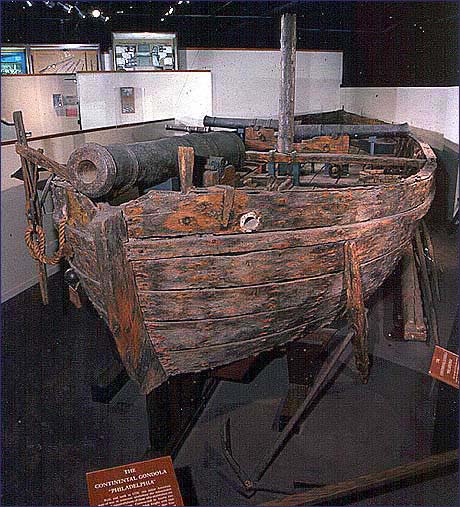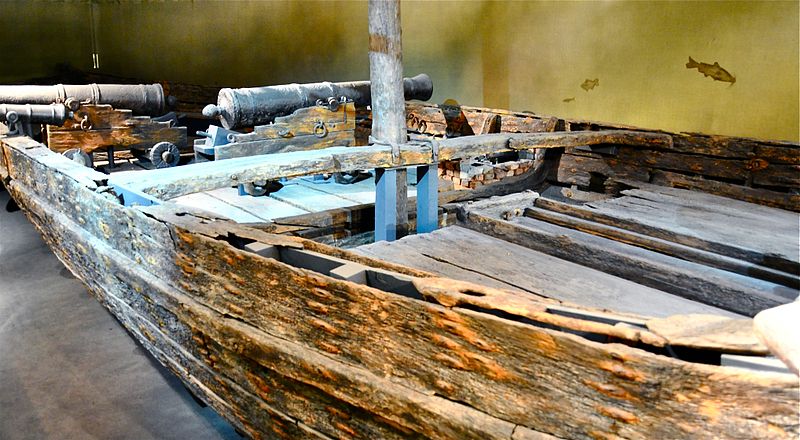
The remains of two 18th century American ships, one uncovered 22 feet below street level in a pit located in what is now the underground security and parking complex of the new World Trade Center construction in New York City, and the other now housed at the Smithsonian’s National Museum of American History in Washington, D.C., have revealed some details of late 18th century colonial and post-colonial U.S. American maritime history.
The first features timber remains discovered 4 years ago while workers were excavating a pit below the area where the World Trade Center once stood. It was subsequently determined to be a late 18th century Hudson River sloop after scientists, applying techniques of dendrochronology at the Columbia University tree-ring lab at the Lamont-Doherty Earth Observatory, dated its original construction from old-growth white oak trees of eastern Pennsylvania to shortly after 1773 in a Philadelphia port. The findings were recently published in a journal issue of the Tree-Ring Society.
Sloops in the late 18th century were generally designed for river travel and used to transport goods and people. This particular boat was suggested by archaeologists and historians to have been in service in the trade routes around New York, Connecticut and the Chesapeake region. But this ship showed evidence of having been sailed at least one time to the Caribbean area, as the timber showed signs of past shipworm infestation, a condition that develops in warm salt water environments. Few late 18th century sloops have been recovered, so not much is known about them, but historians and archaeologists say there were many of them in use, based on written and visual documentation.
Along with the ship timbers, archaeologists recovered cannonballs, ceramics, pipe fragments, buckles, a spoon, a coin, and a button of the British 52nd Regiment. Further analysis will tell scientists more about the sloop and, by extension, more about the late 18th century sloops of the eastern coastal regions of U.S. colonial and post-colonial times.
For Public View: The Oldest Surviving American Fighting Vessel
The other ship, a Revolutionary War period gunboat now on display at the Smithsonian’s National Museum of American History (NMAH) on the downtown Mall of Washington, D.C., was recovered in remarkably good condition from the bottom of Lake Champlain in 1935 by Lorenzo F. Haggulund, a civil engineer. Identified as the gunboat USS Philadelphia, it was exhibited for a number of years at various locations for tourists, after which it was transferred to the NMAH in 1964, along with the 24-pound ball thought to have been responsible for sinking the gunboat during a key battle with the British in 1776.
_______________________________
Three views (above and below) of the gunboat Philadelphia as exhibited at the National Museum of American History. (Image below, Matthew G. Bisanz, Wikimedia Commons; last image Kevin Burkett, Wikimedia Commons)
________________________________
________________________________
__________________________________________
The gunboat remains are significant in that they represent the oldest surviving American fighting vessel, built in 1776, around the same time or after the construction of the aforementioned sloop recently recovered in New York City. Among the objects recovered from its post-battle resting place were cannons, the hull, and hundreds of other artifacts including shot, cooking utensils, tools, buttons, buckles and human bones.
The gunboat sank in Lake Champlain during the battle of Valcour Island. It was part of a small, newly built fleet that met a British force on October 11, 1776. The battle was hard-fought, but the superior firepower of the British squadron defeated the American flotilla, and sent the Philadelphia to the bottom of the Lake at the end of the first day of a 3-day battle. Though the battle was considered a defeat for the Americans, it was successful in delaying the British campaign and eventually led to the American victory at Saratoga.
The gunboat USS Philadelphia can be seen by visitors in a recently renovated third floor gallery at the Smithsonian National Museum of American History in Washington, D.C. It is complete with the reconstructed original vessel, video footage, painted scrims and display cases exhibiting numerous artifacts recovered from the recovery site.
_______________________________
Read about the most fascinating discoveries with a premium subscription to Popular Archaeology Magazine. Find out what Popular Archaeology Magazine is all about. AND MORE:
On the go? Get the smartphone version of Popular Archaeology as an app or as an ebook.
Popular Archaeology’s annual Discovery Edition eBook is a selection of the best stories published in Popular Archaeology Magazine in past issues, with an emphasis on some of the most significant, groundbreaking, or fascinating discoveries in the fields of archaeology and paleoanthropology and related fields. At least some of the articles have been updated or revised specifically for the Discovery edition. We can confidently say that there is no other single issue of an archaeology-related magazine, paper print or online, that contains as much major feature article content as this one. The latest issue, volume 2, has just been released. Go to the Discovery edition page for more information.









